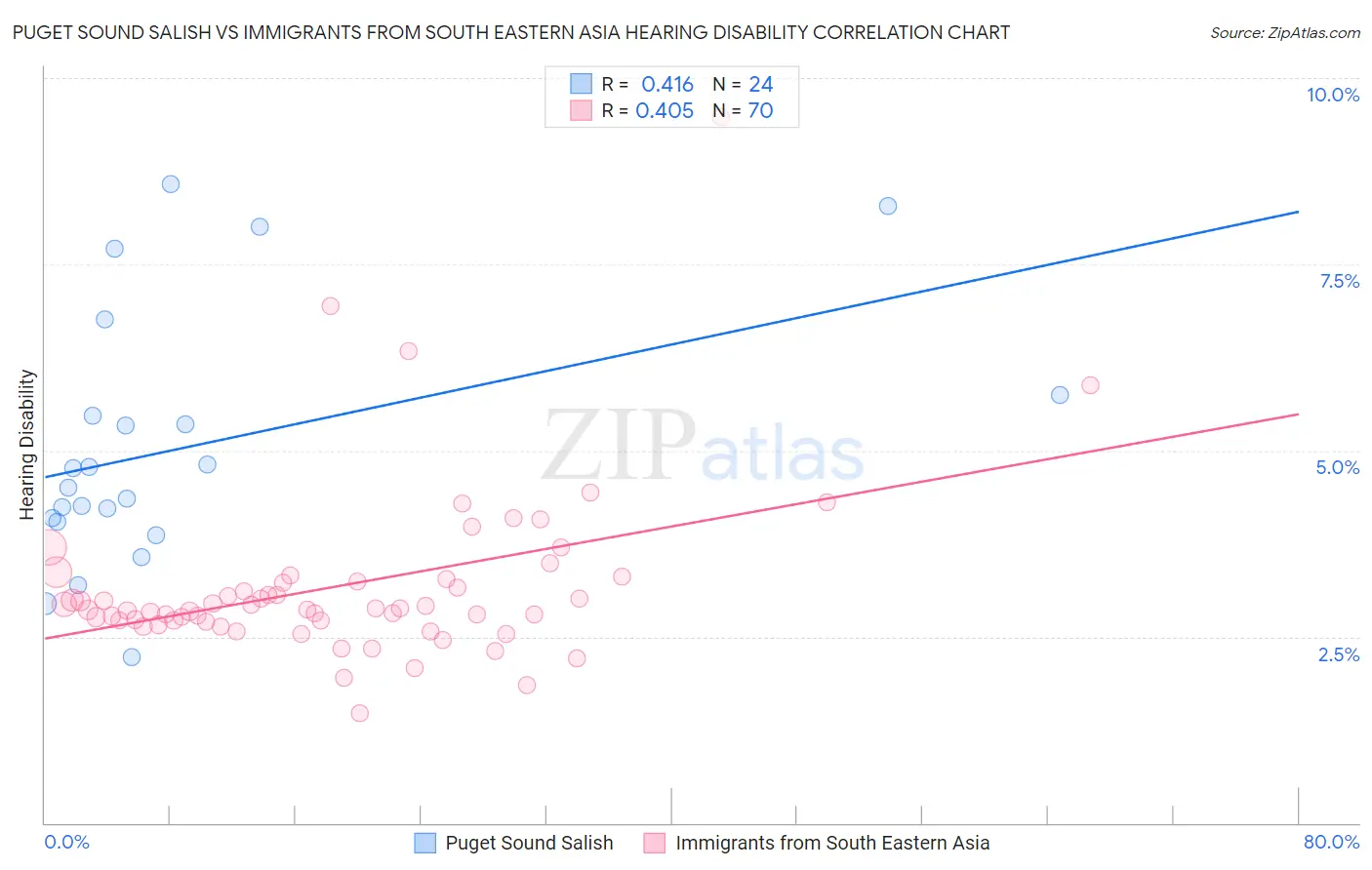Puget Sound Salish vs Immigrants from South Eastern Asia Hearing Disability
COMPARE
Puget Sound Salish
Immigrants from South Eastern Asia
Hearing Disability
Hearing Disability Comparison
Puget Sound Salish
Immigrants from South Eastern Asia
3.9%
HEARING DISABILITY
0.0/ 100
METRIC RATING
315th/ 347
METRIC RANK
3.0%
HEARING DISABILITY
62.9/ 100
METRIC RATING
166th/ 347
METRIC RANK
Puget Sound Salish vs Immigrants from South Eastern Asia Hearing Disability Correlation Chart
The statistical analysis conducted on geographies consisting of 46,152,047 people shows a moderate positive correlation between the proportion of Puget Sound Salish and percentage of population with hearing disability in the United States with a correlation coefficient (R) of 0.416 and weighted average of 3.9%. Similarly, the statistical analysis conducted on geographies consisting of 512,290,375 people shows a moderate positive correlation between the proportion of Immigrants from South Eastern Asia and percentage of population with hearing disability in the United States with a correlation coefficient (R) of 0.405 and weighted average of 3.0%, a difference of 33.5%.

Hearing Disability Correlation Summary
| Measurement | Puget Sound Salish | Immigrants from South Eastern Asia |
| Minimum | 2.2% | 1.5% |
| Maximum | 8.6% | 9.5% |
| Range | 6.3% | 8.0% |
| Mean | 5.0% | 3.2% |
| Median | 4.6% | 2.9% |
| Interquartile 25% (IQ1) | 4.1% | 2.7% |
| Interquartile 75% (IQ3) | 5.6% | 3.2% |
| Interquartile Range (IQR) | 1.5% | 0.53% |
| Standard Deviation (Sample) | 1.7% | 1.2% |
| Standard Deviation (Population) | 1.7% | 1.2% |
Similar Demographics by Hearing Disability
Demographics Similar to Puget Sound Salish by Hearing Disability
In terms of hearing disability, the demographic groups most similar to Puget Sound Salish are Yakama (3.9%, a difference of 0.010%), Hopi (3.9%, a difference of 0.18%), Spanish American (4.0%, a difference of 0.20%), Cajun (3.9%, a difference of 0.29%), and Comanche (4.0%, a difference of 0.33%).
| Demographics | Rating | Rank | Hearing Disability |
| Ottawa | 0.0 /100 | #308 | Tragic 3.8% |
| Scotch-Irish | 0.0 /100 | #309 | Tragic 3.8% |
| Cree | 0.0 /100 | #310 | Tragic 3.8% |
| Americans | 0.0 /100 | #311 | Tragic 3.9% |
| Cajuns | 0.0 /100 | #312 | Tragic 3.9% |
| Hopi | 0.0 /100 | #313 | Tragic 3.9% |
| Yakama | 0.0 /100 | #314 | Tragic 3.9% |
| Puget Sound Salish | 0.0 /100 | #315 | Tragic 3.9% |
| Spanish Americans | 0.0 /100 | #316 | Tragic 4.0% |
| Comanche | 0.0 /100 | #317 | Tragic 4.0% |
| Cheyenne | 0.0 /100 | #318 | Tragic 4.0% |
| Chippewa | 0.0 /100 | #319 | Tragic 4.0% |
| Shoshone | 0.0 /100 | #320 | Tragic 4.0% |
| Paiute | 0.0 /100 | #321 | Tragic 4.1% |
| Seminole | 0.0 /100 | #322 | Tragic 4.1% |
Demographics Similar to Immigrants from South Eastern Asia by Hearing Disability
In terms of hearing disability, the demographic groups most similar to Immigrants from South Eastern Asia are Immigrants from Zimbabwe (3.0%, a difference of 0.14%), Immigrants from Cambodia (3.0%, a difference of 0.20%), Immigrants from Central America (3.0%, a difference of 0.21%), Immigrants from Japan (2.9%, a difference of 0.36%), and Albanian (2.9%, a difference of 0.39%).
| Demographics | Rating | Rank | Hearing Disability |
| Immigrants | Australia | 67.4 /100 | #159 | Good 2.9% |
| Immigrants | Fiji | 67.1 /100 | #160 | Good 2.9% |
| Albanians | 66.6 /100 | #161 | Good 2.9% |
| Immigrants | Japan | 66.3 /100 | #162 | Good 2.9% |
| Immigrants | Central America | 64.9 /100 | #163 | Good 3.0% |
| Immigrants | Cambodia | 64.8 /100 | #164 | Good 3.0% |
| Immigrants | Zimbabwe | 64.2 /100 | #165 | Good 3.0% |
| Immigrants | South Eastern Asia | 62.9 /100 | #166 | Good 3.0% |
| Immigrants | Eastern Europe | 58.1 /100 | #167 | Average 3.0% |
| Immigrants | Greece | 57.9 /100 | #168 | Average 3.0% |
| Arabs | 57.6 /100 | #169 | Average 3.0% |
| Immigrants | Cabo Verde | 56.9 /100 | #170 | Average 3.0% |
| Immigrants | Ukraine | 56.6 /100 | #171 | Average 3.0% |
| Armenians | 56.0 /100 | #172 | Average 3.0% |
| Immigrants | Serbia | 51.1 /100 | #173 | Average 3.0% |